Antonia DaSilva returned to Cape Cod after graduating from Smith College in 2020 and took up gardening at her parents’ house in Orleans. “The natural world here was something I really missed,” says DaSilva. In addition to getting her hands dirty, she began photographing plants in their various stages of growth. This careful observation soon found its way into her painting.
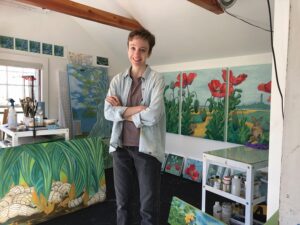
The resulting new body of work is on view in the artist’s debut solo exhibition on Cape Cod at Wellfleet Preservation Hall, where DaSilva is showing 19 paintings rooted in her observations of garden life. Some are straightforward depictions of flowers, like a group of small, lushly painted poppies shown in both their red-petaled glory and in their more subtle state as denuded pods. Other paintings have bloomed in more unexpected directions, with flowers morphing into vaguely threatening characters in fairytale-like narratives of ecological anxiety.
DaSilva is fascinated by “the way that humans intrude into the natural world and the way the natural world intrudes into manmade worlds.” In Rhubarb Clock, a swirling cascade of rhubarb leaves falls into a landscape of purple thistles like a crashing wave. The image recalls the famous print of a clawlike wave by Hokusai, the Japanese printmaker. Clocks peek out from under the leaves that for DaSilva are a symbol of time running out before a natural catastrophe hits Cape Cod.
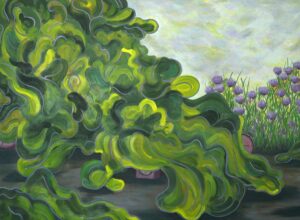
In another painting, Delph Bedroom, purple delphiniums infiltrate a bedroom. The foreground is dominated by towering blossoms rendered in decadent strokes of purple and blue oil paint. Dabs of yellow paint punctuate the center of the flowers like glowing eyes. The viewer must gingerly move beyond the flowers to get a few glimpses of a bedroom, but then the flowers appear again as if they were an invasive species growing up a wall behind the furniture.
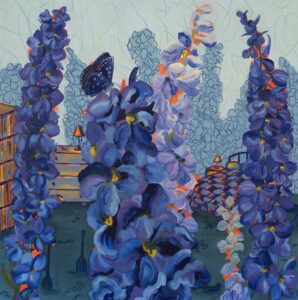
These garden works stem not only from her love of the natural world but also “from my rather overly active imagination,” says DaSilva, who now lives and paints in a Truro cottage on the property of Megan Hinton and Paula Erickson. “I love the land here,” says DaSilva. She has been helping Erickson develop her expansive flower and vegetable gardens — that’s where she continues to find ideas. An old bed frame that was being used as a plant support in the garden inspired Delph Bedroom.
In Growing Pins, as in many of DaSilva’s paintings, the seed of an idea gleaned from the garden germinates to fantastic proportions in her mind and then appears on the canvas. In this moody painting in shades of blue, nasturtium leaves pierced by safety pins appear pained by these intrusions from the human world. But they aren’t helpless victims. Like the delphiniums, their oversize scale renders them ominous, and the leaves’ veins stretch outward like hungry hands. Here, nature is out for revenge.
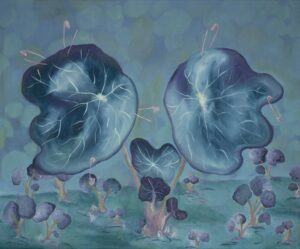
While developing her paintings, DaSilva often writes short narratives to guide her decisions. Working on one painting of crimson flowers in a bathtub, she felt stuck. “I was questioning the choice I had made on the scale of the flowers compared to the tub,” she says. She wrote a short text, which helped her find a logical reason for the oversize flowers. “The narrative gave me permission,” says DaSilva.
DaSilva gives herself permission to engage different modes of painting on a single surface. The flowers are usually painted lushly but the spaces around them are more like illustration in their flatness and emphasis on linework. This is apparent in In the Bath, where the linear tiles contrast dramatically with the painterliness of the flowers. “I’m pulling from things that are very real, like something growing right outside, and from something completely imagined,” she says, “so it makes sense for me to use these different painting languages.”
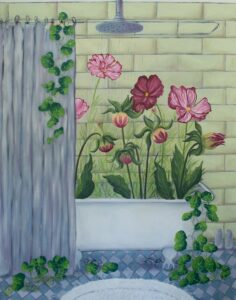
DaSilva says she has always loved illustrated books and cartoons. A reference to fairytales is obvious in her largest painting in the exhibition, a triptych titled All Roads Lead to Provincetown (But First Poppies). She still reads a lot of children’s literature, she says. “As an adult, you realize how disturbing and strange these stories are,” she adds.
In this painting, huge poppies sway in the foreground. Are they a barrier, a threat that could swallow you whole, or an enticing invitation? The language of the painting is innocent, with its cheerful palette and the storybook-like rendering of Provincetown in the distance, but there’s an undercurrent of unease. The orange path leading into the painting looks like a maze, and the rabbits along the way look like stoic guardians.
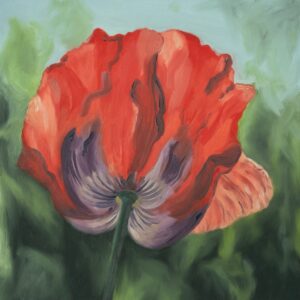
“It’s inspired by the Wizard of Oz,” says DaSilva, who grew up going to Provincetown with her parents from a very young age. “I always had the feeling that I loved Provincetown but that it wasn’t quite real. In this narrative, Provincetown is the Emerald City,” she says. “To get to it, you have to go through the field of poppies, which may make you sleepy or feel other crazy things.”
For DaSilva, painting is a lot like gardening: she builds up slowly, layer by layer, through a process that involves “a lot of looking, observing, and thinking about things over time.” In this territory, her flowers sometimes bloom to epic proportions.

“For me, painting has always felt like a way in which I’m brave that I’m not in everyday normal life,” she says. “I can paint large things, brightly colored things, and I have no qualms about that.”
Planting IN and OUT
The event: Paintings by Antonia DaSilva
The time: Through Nov. 26; reception, Thursday, Nov. 7, 5 to 7 p.m.; artist talk, Tuesday, Nov. 12, 6 to 7 p.m.
The place: Wellfleet Preservation Hall, 335 Main St.
The cost: Free



